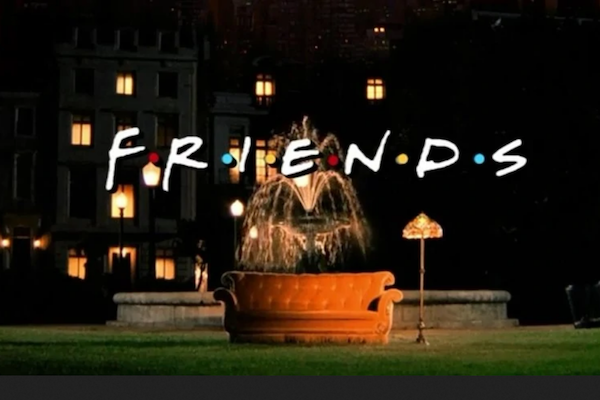It might be time to admit we have a Friends problem. Or rather, we have a little bit of a Friends addiction.
To put things in perspective, let’s look at a few of the ways in which this happy-go-lucky, ‘90s-style sitcom is still making (and expanding) its mark on pop culture. First and foremost, it has to be mentioned that Rolling Stone ran a piece in 2019 commemorating the show’s 25th anniversary with 25 pieces of merch fans can purchase. It doesn’t take much research or imagination to know that plenty of other sitcoms have sold plenty of merch. But the idea of fans purchasing Friends-themed colored pencils, character-inspired Funko Pop figurines, and “Central Perk” coffee shop LEGO sets — 25 years after the show aired — seems a bit much.
Another somewhat incredible sign of the show’s lingering popularity is that before it left Netflix this year, it was listed by numerous publications as one of the streaming service’s most popular shows. Netflix is notoriously stingy about releasing streaming numbers and the like, so this is difficult to speak to with much detail. But as far as we can tell, Friends competed with old, licensed material and brand new shows alike for the entirety of its stay on Netflix. Like The Office, people just can’t seem to quit it.
Modern fanhood of Friends also touches on some bizarre and unexpected areas of entertainment culture. Perhaps most surprising of all is the fact that it’s even entered the modern online gaming industry. If that sentence caught you off guard, we assure you it’s true. Foxy Games has a dedicated Friends title, among it roster of slots, bingo, “slingo” and various other casino games. It’s a digital scratchcard that helps players “relive iconic scenes and characters” as they play. And judging by its prominence on the platform, it has a significant audience.
But is it all just a bit much? Was this show really so good as to be so relevant more than two decades after it originally aired?
This is not to suggest that it’s all bad. I’m a Friends cynic and then some, but even I can acknowledge some of its cultural relevance, and even brilliance. The cast is lovable, and presented a brand of modern adult friendship that — in some ways — I don’t think it’s so wrong to aspire to. Some of the actors have real talent, as is most oddly evidenced by Matt LeBlanc’s almost shockingly delightful Episodes. And while this is a whole separate topic unto itself (someone, somewhere, has probably written a dissertation on it), there’s a sort of pre-9/11 New York simplicity to half of the show that one can’t help but feel nostalgic for. There are good things.
Friends even sparked some notable traditions I think it’s okay to be grateful for. The biggest example might be that people today still celebrate “Friendsgiving”, and the concept basically originated with the show. As Vulture’s ranking of Friends Thanksgiving episodes reminds us, this show paid special attention to this holiday. It’s not a stretch, in fact, to say that the show changed the very nature of Thanksgiving for college students and young adult friends, at least on occasions when they can’t spend the holiday with family. This is a legitimate, fun cultural contribution.
So, Friends remains bizarrely relevant, and has even left us with some legitimately good material, memories, and traditions. There are two reasons I’m asking if it’s still time to put the show to bed, though. The first, and simplest, is that I’m convinced it’s not that good. In fact, I’m in the (admittedly rare) camp that would rank it behind Seinfeld (in some ways its predecessor) and How I Met Your Mother (its unofficial successor) — even if those shows have their own issues. All these years later, it’s just difficult to buy too much of the material. Even for a feel-good, occasionally self-deprecating and self-aware sitcom, it’s rarely believable to the extent that the relationships playing out on screen seem to matter.
The second and more serious reason I question the show’s ongoing cultural dominance, though, is that it had a representation problem. I can’t say it much better than Vox, which ran an article stating that Friends was “homophobic and way too white.” That about sums it up. The show was consistently and problematically prone to displays of mockery and/or discomfort with anything other than straight, non-binary orientation. And it was also about the whitest show in memory (though to be fair, How I Met Your Mother seemed to try to give it a run for its money).
Now, I’m not blind to the fact that times change, and progress wins out — even if often at a painfully slow pace. I’ll give the writers and all involved a modicum of credit and assume that these problems would be far less severe today. I also know there are people for whom Friends is a very special show, who are not themselves against LGBTQ and non-white representation.
What I am suggesting though is that this show should be properly contextualized rather than worshipped — which it more or less is today. Friends doesn’t have to be locked away and shunned. But we should put it to bed as a full-fledged cultural phenomenon of the present, and treat it as the flawed but impactful piece of past entertainment it is.
This article was written by a Tagg Magazine outside partner.

